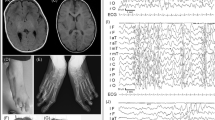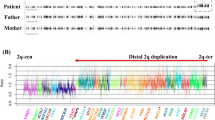Abstract
We report a recurrent microdeletion syndrome causing mental retardation, epilepsy and variable facial and digital dysmorphisms. We describe nine affected individuals, including six probands: two with de novo deletions, two who inherited the deletion from an affected parent and two with unknown inheritance. The proximal breakpoint of the largest deletion is contiguous with breakpoint 3 (BP3) of the Prader-Willi and Angelman syndrome region, extending 3.95 Mb distally to BP5. A smaller 1.5-Mb deletion has a proximal breakpoint within the larger deletion (BP4) and shares the same distal BP5. This recurrent 1.5-Mb deletion contains six genes, including a candidate gene for epilepsy (CHRNA7) that is probably responsible for the observed seizure phenotype. The BP4–BP5 region undergoes frequent inversion, suggesting a possible link between this inversion polymorphism and recurrent deletion. The frequency of these microdeletions in mental retardation cases is ∼0.3% (6/2,082 tested), a prevalence comparable to that of Williams, Angelman and Prader-Willi syndromes.
This is a preview of subscription content, access via your institution
Access options
Subscribe to this journal
Receive 12 print issues and online access
$209.00 per year
only $17.42 per issue
Buy this article
- Purchase on Springer Link
- Instant access to full article PDF
Prices may be subject to local taxes which are calculated during checkout





Similar content being viewed by others
Accession codes
References
Stankiewicz, P. & Lupski, J.R. Genome architecture, rearrangements and genomic disorders. Trends Genet. 18, 74–82 (2002).
de Vries, B.B. et al. Diagnostic genome profiling in mental retardation. Am. J. Hum. Genet. 77, 606–616 (2005).
Sharp, A.J. et al. Discovery of previously unidentified genomic disorders from the duplication architecture of the human genome. Nat. Genet. 38, 1038–1042 (2006).
Jiang, Z. et al. Ancestral reconstruction of segmental duplications reveals punctuated cores of human genome evolution. Nat. Genet. 39, 1361–1368 (2007).
Zody, M.C. et al. Analysis of the DNA sequence and duplication history of human chromosome 15. Nature 440, 671–675 (2006).
Gimelli, G. et al. Genomic inversions of human chromosome 15q11-q13 in mothers of Angelman syndrome patients with class II (BP2/3) deletions. Hum. Mol. Genet. 12, 849–858 (2003).
Kurotaki, N., Stankiewicz, P., Wakui, K., Niikawa, N. & Lupski, J.R. Sotos syndrome common deletion is mediated by directly oriented subunits within inverted Sos-REP low-copy repeats. Hum. Mol. Genet. 14, 535–542 (2005).
Lupski, J.R. Genome structural variation and sporadic disease traits. Nat. Genet. 38, 974–976 (2006).
Osborne, L.R. et al. A 1.5 million-base pair inversion polymorphism in families with Williams-Beuren syndrome. Nat. Genet. 29, 321–325 (2001).
Sharp, A.J., Cheng, Z. & Eichler, E.E. Structural variation of the human genome. Annu. Rev. Genomics Hum. Genet. 7, 407–442 (2006).
Peiffer, D.A. et al. High-resolution genomic profiling of chromosomal aberrations using Infinium whole-genome genotyping. Genome Res. 16, 1136–1148 (2006).
Iafrate, A.J. et al. Detection of large-scale variation in the human genome. Nat. Genet. 36, 949–951 (2004).
Locke, D.P. et al. Linkage disequilibrium and heritability of copy-number polymorphisms within duplicated regions of the human genome. Am. J. Hum. Genet. 79, 275–290 (2006).
Sebat, J. et al. Large-scale copy number polymorphism in the human genome. Science 305, 525–528 (2004).
Sharp, A.J. et al. Segmental duplications and copy-number variation in the human genome. Am. J. Hum. Genet. 77, 78–88 (2005).
Simon-Sanchez, J. et al. Genome-wide SNP assay reveals structural genomic variation, extended homozygosity and cell-line induced alterations in normal individuals. Hum. Mol. Genet. 16, 1–14 (2007).
Wong, K.K. et al. A comprehensive analysis of common copy-number variations in the human genome. Am. J. Hum. Genet. 80, 91–104 (2007).
de Smith, A.J. et al. Array CGH analysis of copy number variation identifies 1284 new genes variant in healthy white males: implications for association studies of complex diseases. Hum. Mol. Genet. 16, 2783–2794 (2007).
Zogopoulos, G. et al. Germ-line DNA copy number variation frequencies in a large North American population. Hum. Genet. 122, 345–353 (2007).
Elmslie, F.V. et al. Genetic mapping of a major susceptibility locus for juvenile myoclonic epilepsy on chromosome 15q. Hum. Mol. Genet. 6, 1329–1334 (1997).
Neubauer, B.A. et al. Centrotemporal spikes in families with rolandic epilepsy: linkage to chromosome 15q14. Neurology 51, 1608–1612 (1998).
Orr-Urtreger, A. et al. Mice deficient in the alpha7 neuronal nicotinic acetylcholine receptor lack alpha-bungarotoxin binding sites and hippocampal fast nicotinic currents. J. Neurosci. 17, 9165–9171 (1997).
Sahoo, T. et al. Identification of novel deletions of 15q11q13 in Angelman syndrome by array-CGH: molecular characterization and genotype-phenotype correlations. Eur. J. Hum. Genet. 15, 943–949 (2007).
Sahoo, T. et al. Array-based comparative genomic hybridization analysis of recurrent chromosome 15q rearrangements. Am. J. Med. Genet. A. 139, 106–113 (2005).
Wang, N.J., Liu, D., Parokonny, A.S. & Schanen, N.C. High-resolution molecular characterization of 15q11-q13 rearrangements by array comparative genomic hybridization (array CGH) with detection of gene dosage. Am. J. Hum. Genet. 75, 267–281 (2004).
Erdogan, F. et al. Characterization of a 5.3 Mb deletion in 15q14 by comparative genomic hybridization using a whole genome “tiling path” BAC array in a girl with heart defect, cleft palate, and developmental delay. Am. J. Med. Genet. A. 143, 172–178 (2007).
Stevenson, R.E., Procopio-Allen, A.M., Schroer, R.J. & Collins, J.S. Genetic syndromes among individuals with mental retardation. Am. J. Med. Genet. A. 123, 29–32 (2003).
Larson, S.A. et al. Prevalence of mental retardation and developmental disabilities: estimates from the 1994/1995 National Health Interview Survey Disability Supplements. Am. J. Ment. Retard. 106, 231–252 (2001).
Stevenson, R.E. & Schroer, R.J. Mental retardation in South Carolina: Characteristics of the study population. in Proc. Greenwood Genetic Center (Greenwood Genetic Center, Greenwood, South Carolina, 1996).
Livak, K.J. & Schmittgen, T.D. Analysis of relative gene expression data using real-time quantitative PCR and the ΔΔCt method. Methods 25, 402–408 (2001).
Acknowledgements
We are grateful to R. Krauss and the PARC project for the use and analysis of Illumina SNP genotyping data, funded by US National Institutes of Health (NIH) grant U01 HL069757. This work was supported in part by grants from the NIH (HD043569, E.E.E.), the South Carolina Department of Disabilities and Special Needs (C.S., R.E.S., R.J.S. and C.E.S.), Oxford Genetics Knowledge Park and the Oxford National Institute for Health Research (NIHR) Biomedical Research Centre (R.R. and S.J.L.K.), Fondazione Mariani, CARIPLO and PRIN 2005 (O.Z.), and the Italian Ministry of Health (C.R., P.F., L.C. and M.F.). EEE is an Investigator of the Howard Hughes Medical Institute.
Author information
Authors and Affiliations
Contributions
A.J.S., H.C.M. and E.E.E. contributed to the writing of this paper. The study was coordinated by A.J.S., H.C.M., S.J.L.K., C.R., O.Z., C.C., C.E.S. and E.E.E.; experimental work was done by A.J.S., H.C.M., K.L., C. Baker, F.N., M.D.G., R.C., A.B., G.G., R.R., M.F., L.C., P.F. and M.V.; clinical work was done by R.E.S., R.J.S., B.D.B., C.T., R.G., V.M., S.M., C.S. and C.R.; computational analysis was performed by Y.W., C.X., C. Barbacioru, Z.J., I.C. and G.M.C.
Corresponding author
Ethics declarations
Competing interests
K. Li, A.J. Broomer, Y.Wang, C. Xiao, C. Barbacioru and C. Chen are employees of Applied Biosystems, Inc. and have stock options in the company.
Supplementary information
Supplementary Text and Figures
Supplementary Note, Supplementary Figures 1–6, Supplementary Tables 1 and 2 (PDF 1070 kb)
Rights and permissions
About this article
Cite this article
Sharp, A., Mefford, H., Li, K. et al. A recurrent 15q13.3 microdeletion syndrome associated with mental retardation and seizures. Nat Genet 40, 322–328 (2008). https://doi.org/10.1038/ng.93
Received:
Accepted:
Published:
Issue Date:
DOI: https://doi.org/10.1038/ng.93
This article is cited by
-
Neurodevelopmental disorders—high-resolution rethinking of disease modeling
Molecular Psychiatry (2023)
-
Impaired OTUD7A-dependent Ankyrin regulation mediates neuronal dysfunction in mouse and human models of the 15q13.3 microdeletion syndrome
Molecular Psychiatry (2023)
-
Mice with mutations in Trpm1, a gene in the locus of 15q13.3 microdeletion syndrome, display pronounced hyperactivity and decreased anxiety-like behavior
Molecular Brain (2021)
-
Sex-specific recombination patterns predict parent of origin for recurrent genomic disorders
BMC Medical Genomics (2021)
-
Deubiquitylases in developmental ubiquitin signaling and congenital diseases
Cell Death & Differentiation (2021)



